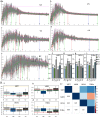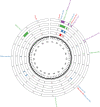QTL detection for bread wheat processing quality in a nested association mapping population of semi-wild and domesticated wheat varieties
- PMID: 35313801
- PMCID: PMC8935700
- DOI: 10.1186/s12870-022-03523-x
QTL detection for bread wheat processing quality in a nested association mapping population of semi-wild and domesticated wheat varieties
Abstract
Background: Wheat processing quality is an important factor in evaluating overall wheat quality, and dough characteristics are important when assessing the processing quality of wheat. As a notable germplasm resource, semi-wild wheat has a key role in the study of wheat processing quality.
Results: In this study, four dough rheological characteristics were collected in four environments using a nested association mapping (NAM) population consisting of semi-wild and domesticated wheat varieties to identify quantitative trait loci (QTL) for wheat processing quality. A total of 49 QTL for wheat processing quality were detected, explaining 0.36-10.82% of the phenotypic variation. These QTL were located on all wheat chromosomes except for 2D, 3A, 3D, 6B, 6D and 7D. Compared to previous studies, 29 QTL were newly identified. Four novel QTL, QMlPH-1B.4, QMlPH-3B.4, QWdEm-1B.2 and QWdEm-3B.2, were stably identified in three or more environments, among which QMlPH-3B.4 was a major QTL. Moreover, eight important genetic regions for wheat processing quality were identified on chromosomes 1B, 3B and 4D, which showed pleiotropy for dough characteristics. In addition, out of 49 QTL, 15 favorable alleles came from three semi-wild parents, suggesting that the QTL alleles provided by the semi-wild parent were not utilized in domesticated varieties.
Conclusions: The results show that semi-wild wheat varieties can enrich the existing wheat gene pool and provide broader variation resources for wheat genetic research.
Keywords: Nested association mapping (NAM) population; Processing quality; Quantitative trait locus; Semi-wild wheat; Wheat.
© 2022. The Author(s).
Conflict of interest statement
The authors declare that they have no competing interests.
Figures


Similar articles
-
Quantitative trait loci influencing endosperm texture, dough-mixing strength, and bread-making properties of the hard red spring wheat breeding lines.Genome. 2011 Jun;54(6):460-70. doi: 10.1139/g11-012. Epub 2011 May 26. Genome. 2011. PMID: 21615298
-
Analysis of genetic control and QTL mapping of essential wheat grain quality traits in a recombinant inbred population.PLoS One. 2019 Mar 6;14(3):e0200669. doi: 10.1371/journal.pone.0200669. eCollection 2019. PLoS One. 2019. PMID: 30840619 Free PMC article.
-
QTL mapping for yield-related traits in wheat based on four RIL populations.Theor Appl Genet. 2020 Mar;133(3):917-933. doi: 10.1007/s00122-019-03515-w. Epub 2020 Jan 2. Theor Appl Genet. 2020. PMID: 31897512
-
Phenology and related traits for wheat adaptation.Heredity (Edinb). 2020 Dec;125(6):417-430. doi: 10.1038/s41437-020-0320-1. Epub 2020 May 26. Heredity (Edinb). 2020. PMID: 32457509 Free PMC article. Review.
-
Unraveling the Secrets of Early-Maturity and Short-Duration Bread Wheat in Unpredictable Environments.Plants (Basel). 2024 Oct 12;13(20):2855. doi: 10.3390/plants13202855. Plants (Basel). 2024. PMID: 39458802 Free PMC article. Review.
Cited by
-
Identification of Quantitative Trait Loci Associated with Plant Adaptation Traits Using Nested Association Mapping Population.Plants (Basel). 2024 Sep 20;13(18):2623. doi: 10.3390/plants13182623. Plants (Basel). 2024. PMID: 39339597 Free PMC article.
-
Identification and validation of quantitative trait loci for seven quality-related traits in common wheat (Triticum aestivum L.).Theor Appl Genet. 2025 Feb 26;138(3):57. doi: 10.1007/s00122-025-04851-w. Theor Appl Genet. 2025. PMID: 40009158
-
Pleiotropic Quantitative Trait Loci (QTL) Mining for Regulating Wheat Processing Quality- and Yield-Related Traits.Plants (Basel). 2024 Sep 10;13(18):2545. doi: 10.3390/plants13182545. Plants (Basel). 2024. PMID: 39339520 Free PMC article.
References
-
- Brenchley R, Spannagl M, Pfeifer M, Barker GLA, D’Amore R, Allen AM, McKenzie N, Kramer M, Kerhornou A, Bolser D, Kay S, Waite D, Trick M, Bancroft I, Gu Y, Huo N, Luo MC, Sehgal S, Gill B, Kianian S, Anderson O, et al. Analysis of the bread wheat genome using whole-genome shotgun sequencing. Nature. 2012;491:705–710. - PMC - PubMed
-
- Mann G, Diffey S, Cullis B, Azanza F, Martin D, Kelly A, McIntyre L, Schmidt A, Ma WJ, Nath Z, Kutty I, Leyne PE, Rampling L, Quail KJ, Morell MK. Genetic control of wheat quality: interactions between chromosomal regions determining protein content and composition, dough rheology, and sponge and dough baking properties. Theor Appl Genet. 2009;118:1519–1537. - PubMed
-
- Payne PI, Holt LM, Worland AJ, Law CN. Structural and genetical studies on the high-molecular-weight subunits of wheat glutenin. Theor Appl Genet. 1982;63:129–138. - PubMed
Publication types
MeSH terms
LinkOut - more resources
Full Text Sources
Research Materials

